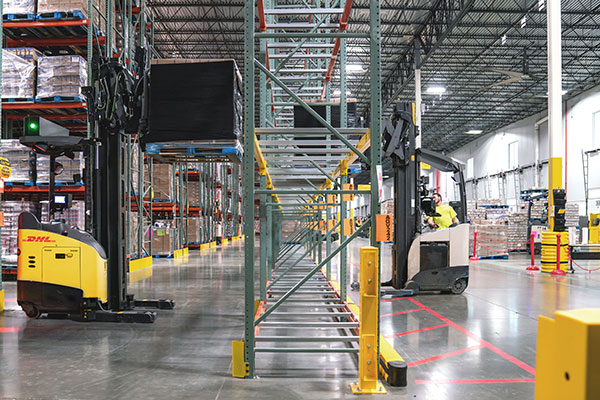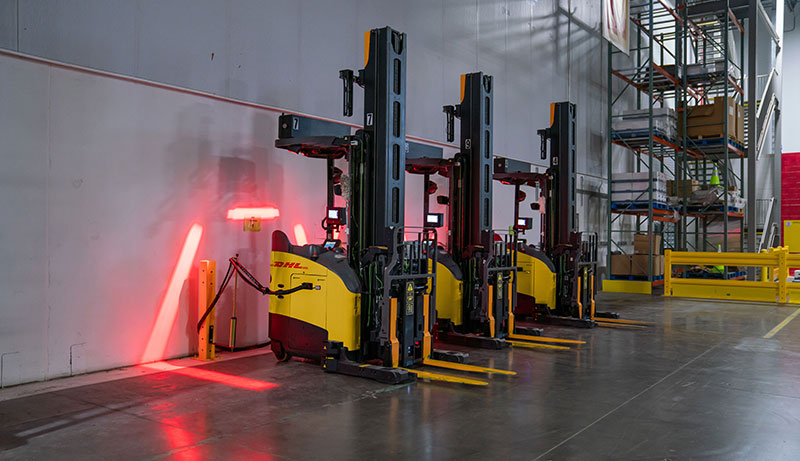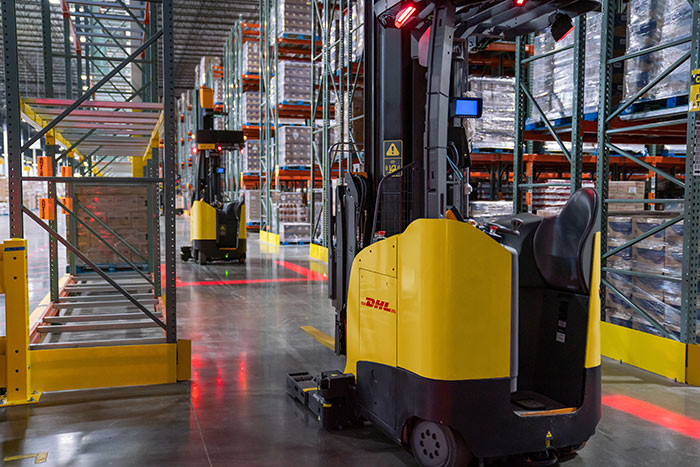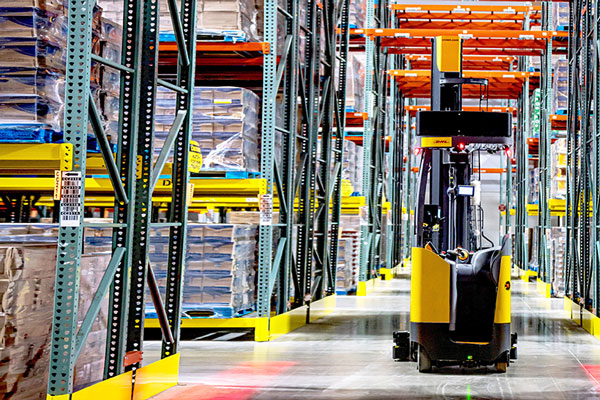In January 2018, DHL Supply Chaindeployed six autonomous mobile robots (AMR) from Locus Robotics in an 18,000-square-foot area in a...
In January 2018, DHL Supply Chaindeployed six autonomous mobile robots (AMR) from Locus Robotics in an 18,000-square-foot area in a facility handling medical devices. Long considered one of the most innovative of the world’sthird-party logistics (3PL)providers, DHL Supply Chain understood a lot was still to be learned from an immature technology, but it wanted to get ahead of the curve and its competition.
![]()
Fast forward, and DHL recently announced it has deployed more than 2,000 Locus bots in North America and has surpassed 100 million units picked across more than a dozen North American facilities. There have been a lot of learnings along the way.
The same organization is now tackling autonomous lift trucks. As it did with AMRs, DHL Supply Chain is starting small, with a fleet of nine autonomous lift trucks (Crown Equipment) in an 800,000-square-foot facility in Findlay, Ohio. As with the AMRs, the initial application is limited to a portion of the 800,000-square-foot facility and is managing a select group of mid- to slow-moving SKUs. The application is also measured, limited to the putaway and retrieval of pallets from double-deep pallet rack going up six locations.
However, if history is any guide, we can expect those numbers to expand in the coming years as the technology matures, and as DHL Supply Chain gains experience and can apply its learnings to other processes. In fact, the organization is already piloting a competing technology in another facility, as it did with AMRs, and eyeing additional locations where it services the same client as in Findlay.
As with AMRs, operational reasons called for bringing in more automation, says Mark Smith, senior vice president of operations. “In 2018 and 2019, before the pandemic, labor challenges were gaining momentum, and we knew we had to do something to change the face of that game,” says Smith.
But, so was staying ahead of the competition by having a seat at the table in the advancement of a promising technology. That is also the case with autonomous lift trucks, says Sally Miller, CIO North America for DHL Supply Chain.
She notes that DHL has accelerated its digitalization program in response to 12 different trends it monitors and believes will impact the supply chain. Examples of those trends include data analytics, visibility and autonomous vehicles. “Innovation is the future of our business,” she says.
Smith and Miller both acknowledge that autonomous lift trucks have a way to go before they are routinely deployed. But they also expect the technology to mature quickly, especially as more vehicles are deployed in the field, much like the way AMR technology expanded.
“Operationally, we’re probably two to five years from where it will evolve into our sites commonly,” says Smith. “Right now, people are more productive than the autonomous vehicles when they’re working. But we know it’s just a matter of time before [the vehicles] gain efficiency and productivity, and we deploy more of them.”
Getting started
Autonomous lift trucks had been on the radar for a number of years, but DHL Supply Chain began looking at them earnestly in 2018. Responding to the labor challenge was certainly a catalyst, says Smith, who adds, “we knew we had to automate our processes to keep up with growth.”
![]()
Autonomous reach trucks are capable of storing and retrieving pallets up to five levels high in the DHL facility.
But another catalyst was the evolution going on inside distribution centers as a result of changing consumer expectations. “When I began in this role eight years ago, our focus was on uptime and getting projects done on time and on budget,” Miller recalls. “Then came the Amazon effect, which has attracted a lot of venture capital money and automation solutions that were flexible, had different financial models like robotics-as-a-service, and addressed labor challenges. My role changed and my focus became how we can integrate these with our existing technologies and be leaders.”
Miller says DHL’s process is similar regardless of the technology: Her team learns about new technologies from trade shows, such as ProMat and Modex, and from discussions with startups, venture capitalists and established solution providers like Crown.
From those discussions, DHL goes through a proof of concept, and if it survives that stage, on to a pilot. If it makes it through the pilot stage, a technology goes into a product stage, where plans are put in place to roll out the technology. “By getting our hands on things, we can see where they might fit,” says Miller. “Not everything makes it to the product stage.”
Part of what attracted DHL to the concept of autonomous lift trucks was the sheer scale of its operations: An estimated 25 million miles traveled a year on manual lift trucks across 500 facilities.
“There is tremendous potential for improvement,” Miller says. The other is that around 2018, traditional materials handling equipment (MHE) vendors, such as Crown and JBT in this instance, were getting into the game. The startups DHL had experimented with didn’t make it through the proof of concept stage.
However, “when we got our hands on the Crown unit, travel and lift times were consistent, and we were able to continually improve on performance. The startups we worked with just didn’t hit the same performance levels,” Miller recalls. “With MHE vendors getting into the game, we knew we could get traction.”
The people side of automation
Despite working with an established vendor, autonomous lift trucks are not yet plug and play. They still have a way to go.
“Right now, people are more productive than autonomous vehicles, and in my mind, operationally, we’re two to five years before they will be routinely deployed into our sites,” says Smith. At the same time, he adds, “after working with them, we know it’s just a matter of time before we see efficiency and productivity gains.”
Those realities led to about a year of upfront work before going live in June 2021.
On the OEM side, work between Crown and JBT helped integrate JBT’s guidance and control system into Crown’s lift trucks. On DHL’s side, there was engineering work to integrate the technology with the facility’swarehouse management system (WMS)and to change the layout of the facility. DHL determined early on that it didn’t want to mix conventional and autonomous vehicles in the same workspace for safety reasons.
![]()
Lift trucks receive an opportunity charge during the shift.
“With AMRs, you can mix people and autonomous vehicles, so there isn’t as much of a need to revisit all of your processes,” Miller says. “That’s something that companies underestimate with autonomous lift trucks: People want to drop in the new technology and declare victory.”
In this project, a cross-functional team representing IT and operations, along with resources from solution design and operating expense teams, worked on the project. “As we rolled up our sleeves, we realized there were virtual barriers and physical barriers that we had to deal with,” Smith says.
Bring on the taskers
The introduction of autonomous lift trucks created the opening for a new role on the floor: A tasker. A total of eight taskers were selected to monitor the fleet of nine vehicles. The operators are spread across multiple shifts in a facility that operates seven days a week, so the whole team isn’t working at one time. They work from a control room to remotely monitor operations and intervene if an operational issue arises.
According to Mark Smith, senior vice president of operations, the job was posted like any other job, including a job description along with a list of the job requirements. After the selection process, taskers went through a formal training session that included time with Crown and JBT so that they understood the software that manages the autonomous lift trucks. After training, they were embedded in the project. “All of the taskers already had familiarity with the building, and then they went through the launch with us,” Smith says.
According to Sally Miller, CIO for North America, in the initial implemention, one tasker monitored three lift trucks. As DHL has become more familiar with the trucks and improved the process, one tasker per shift can now monitor the entire fleet. In fact, in the final accepted system, one tasker can monitor up to 12 vehicles. “That’s where you get your ROI,” she says, “reducing your interventions so you don’t have to have as many people monitoring individual units.”
The virtual barrier was related to people, as is often the case when bringing in new technology. It was important to communicate to the workforce what they were doing, why they were doing it, and how it might impact jobs.
“We held a number of town hall meetings and were very transparent,” says Smith. “Our associates have embraced the technology. They’re aware of the issues we have with turnover and absenteeism because of the overtime they’re being asked to work.” As happened when DHL rolled out AMRs, they found that associates like working in environments with cutting-edge technology.
While lift truck operators may have been concerned about losing their jobs, the reality was that DHL created a new team of eight virtual operators known as taskers. They monitor the autonomous lift trucks from a control center as they perform their tasks. In addition, they have a team of trained supervisors dedicated to that area. And, since the vehicles can operate either manually or autonomously, the taskers and the supervisors can intervene if the lift truck runs into an issue.
“The taskers and supervisors manage the volume from an order management perspective and manage oversight of the lift trucks,” Smith says.
Issues that led to intervention early in the project included unreadable bar codes, bad pallets or poorly built pallet loads, and cobwebs. The latter confused the cameras, which misread them as bar codes. “We had a lot of human intervention on the front end,” Smith says. “A year later, we’ve cut the manual interventions in half.”
Engineering a solution
The physical barrier was another matter. During the proof of concept, it was decided to segregate the autonomous lift trucks in their own area, away from manually operated lift trucks. To do that, DHL created a pallet storage area for slow-moving SKUs. It was located with the shortest possible travel time between the inbound and outbound areas.
“The lift trucks aren’t fast enough to handle our fastest-moving SKUs, where we need to clear out a lot of pallets at top speed,” Smith notes. In all, the autonomous lift trucks handle between 10% and 15% of the total SKUs in an area representing about 25% of the total building. Pallets are stored in a double-deep pallet rack that reaches six levels high.
![]()
Autonomous lift trucks are still an emerging technology, but DHL plans to take learnings from Ohio to expand their use in other facilities.
Perhaps the last piece was integrating the autonomous lift trucks with DHL’s WMS. According to Smith, that was the least complicated part of the integration. “It went very smoothly, and now we have that baseline capability that we can roll out to other facilities,” he says.
In the final process, conventional lift trucks deliver pallets from receiving to a drop zone adjacent to the storage area for slow-moving SKUs. Those pallets are picked up by the autonomous lift trucks and put away into storage. On the outbound side, pallets are retrieved by the autonomous lift trucks and delivered to the drop zone, where they are picked up by conventional lift trucks and taken to shipping.
After about 18 months of operation, Smith says they have learned along the way. For example: Who would’ve expected that cobwebs would be an issue? “But we have those lift trucks up and running; they’re doing the job they were designed to do in a production environment,” he adds.
Based on the experience in Findlay, DHL is now experimenting with autonomous lift trucks from Hysterin another facility, and considering other locations for the equipment from Crown and JBT. Miller and Smith believe their experience with emerging technologies like autonomous lift trucks is key to maintaining the 3PL’s competitive advantage.
“When we began this project, we said: We’re the biggest in the industry; we have to figure this out and make it work,” says Smith. “We took on that challenge and made it work.”
Putting autonomous lift trucks to work in a pallet warehouse
The technology is still maturing, says DHL Supply Chain, but autonomous lift trucks are moving full pallets and delivering value in a production setting in Ohio.
![]()
DHL Supply Chain
Location:Findlay, Ohio
Size:800,000 square feet
Items:Palletized food products
In Northwest Ohio, DHL Supply Chain has rolled out a fleet of nine autonomous lift trucks to manage the putaway and retrieval of a select array of SKUs. The trucks work in an area of the warehouse that has been segregated for the storage of mid- to slow-moving SKUs. The area is also relatively near the inbound and outbound areas of the facility to reduce travel time.
Receiving: The process is initiated when inbound pallets are received in the warehouse. Operators on conventional lift trucks deliver the pallets to a rack location in a drop zone area. Essentially, it acts as a pallet-sized putwall. The drop zone area also serves as a border between where conventional lift trucks operate and autonomous lift trucks operate.
Putaway: Once pallets are in place, an autonomous lift truck is tasked with retrieving a pallet from the drop zone and delivering it to a storage location in an area that consists of double-deep pallet rack that is six levels high. The pallets are now available to promise.
Retrieval:When a pallet is required to fill an order, an autonomous lift truck is tasked with retrieving it from a storage location. The lift truck then delivers it to a location in the drop zone.
Shipping:Operators on conventional lift trucks retrieve the pallet from the drop zone and transport them to shipping, where they will be loaded onto an outbound truck.
System suppliers
Autonomous Lift Trucks: Crown and JBT











 粤公网安备 44010602003952号
粤公网安备 44010602003952号